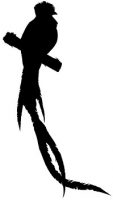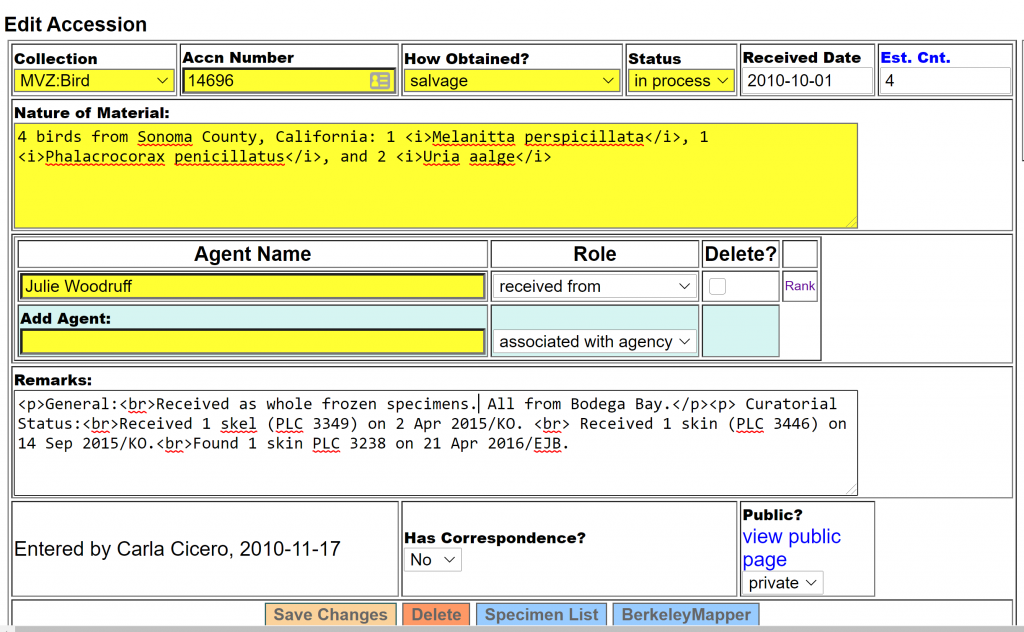Bird Curatorial Manual | Pest Management

Jump to Section:
Overview of Pest Control
All bird specimens coming into the collection must go through the MVZ pest control process. This entails freezing the specimens in a case in the Prep Lab walk-in freezer for one week, and holding them in quarantine for another week before moving them into the collection spaces. Anyone working in the collection should be vigilant about watching for pests, and report any signs or live animals to a Curator immediately.
See the MVZ Handbook section on Pest Control for detailed procedures.
Post-quarantine Organization
Cases in the Quarantine Room (VLSB 3142) should be checked weekly to see which specimens are ready to go into the collection spaces. Once specimens have finished the quarantine process, they should be moved out and handled as follows:
Returns of loans: Specimens should get reinstalled into the main collection. Find the location where the specimens belong; there should be a blue slip in the place of every specimen, or group of specimens, that have been removed for that loan. Put the specimens back exactly where they belong as indicated by the MVZ number(s) on the blue slip. If specimens cannot be reinstalled immediately, they should be put in the case that is just to the left of the mailing table in the curatorial work area of the museum (southwest corner of the MVZ).
Uncataloged material: Specimens that are not yet cataloged should go into one of the curatorial holding cases for birds. These cases are located throughout the museum: in the curatorial work area; general collections space (room 3140 near the Quarantine Room); and near Curator Bowie’s office (northeast corner of MVZ). Most specimens will go in cases A-E in the curatorial work area, or in cases in the general collection space (Backroom A-K). Specimens received from Curators may also go in one of their dedicated cases; talk to the Staff Curator before putting those away.
Prior to putting specimens into a case, the following steps should be followed:
- Find the accession number that goes with each specimen or set of specimens. The accession number and associated specimen(s) should be written on the freezing slip that is placed on the outside of the case as it moves through the pest control process. Specimens that have not been accessioned yet should go into the case that is just to the left of the mailing table in the curatorial work area. The specimens should have a note (post-it) indicating that they are not yet accessioned.
- For accessioned specimens, first check Arctos to see if there are multiple specimens for that accession. You need permission for transactions in order to do this (a Staff Curator can grant that). In Arctos, go to Manage Data –> Transactions –> Find Accession. Enter the accession number in the ‘Accn Number’ field and hit return/search.
- If there is only one specimen in that accession, you will need to find a location to put it (find available space in one of the cases described above). The specimen should go in its own tray with a post-it that has the accession number.
- If there is more than one specimen in that accession, check the Arctos remarks to see if any of the other specimens have been received for that accession. If so, put the specimen with others from the same accession.
- If it is a multi-specimen accession but this is the first specimen received post-quarantine, find a location to put it that will accommodate the rest of the accession. This may require an entire drawer for large accessions, or a smaller tray if there are just a few specimens in that accession. Place a post-it with the accession number on the smaller tray or the outside of the drawer.
- In Arctos, edit the accession remarks under Curatorial Status to add the type of material (e.g., skin, skeleton, wing, etc.), preparator number with initials, date received, and your initials, e.g., “Received 1 skel (PLC 3349) on 2 Apr 2015/KO.” Each new entry should be on a separate line; use html line breaks (< br >) to separate the lines. Be sure to hit Save Changes! See screenshots below.
- Update the Google document “log – newbirdaccns” (Staff Curator will share it with you) – worksheet “Bird Curatorial Case Organization” – with the location of the accession. The worksheet shows all of the curatorial holding cases for bird specimens, and lists the accessions that are on each tray in each case. If the accession has already been entered, you don’t need to change anything unless it is moved to a different location, or if a new drawer is added with more specimens from the same accession.
- Finally, cross off the specimens on the freezing slip as they are put in a case. Once all specimens listed on the freezing slip have been put into a case, tear up the slip and recycle it. Please do not leave slips that have been completed, as that leads to confusion about the status of the specimens on that slip!


